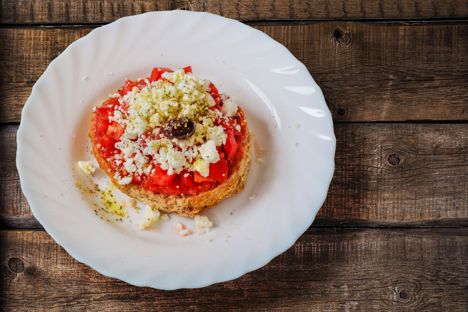
8 must-try dishes when you're in Crete
Crete isn't just home to stunning blue waters and dramatic mountains; it has a whole host of food traditions and delicious local dishes to sample, as we discover.
8 must-try dishes when you're in Crete
Crete isn't just home to stunning blue waters and dramatic mountains; it has a whole host of food traditions and delicious local dishes to sample, as we discover.
Cretan cuisine is rich and varied; plenty of its dishes involve local meats such as lamb, goat, chicken and pork, but the abundance of fresh seafood means fish and shellfish are always on the menu, and its fertile land is responsible for an abundance of vegetables including courgettes, aubergines and tomatoes, enjoyed with plenty of first class olive oil (Crete is responsible for around a third of Greece's production). Cherished local dishes include snails, which have been eaten on the island for thousands of years, as well as its own barbecue style antikristo. Several of the most prized Cretan products have earned Protected Designation of Origin status, including Graviera cheese, olive oil and paximadia, or rusks.
As the largest Greek island – and fifth largest in the Mediterranean Sea – Crete attracts millions of holidaymakers every year, who are won over by its blue seas, hot weather, stunning scenery and fascinating history. But the island is well worth a visit for a true taste of gourmet Greece – below, we've rounded up just some of the fantastic meals to try while you're in Crete.
Chochlioi bourbouristi (snails)
Chochlioi – or snails – are a loved local dish, eaten on the island for thousands of years. Crete is home to snail farms, but locals also forage for them in the mountains after rain. In the traditional chochlioi bourbouristi (boubouristi comes from a word meaning 'face down', a reflection of how they are cooked), snails are boiled in salted water, before being lightly coated with flour and fried in olive oil, before they are finished with vinegar and rosemary.
Apáki (smoked pork)
A Cretan delicacy, apáki is a cured pork loin which is marinated in vinegar and then smoked with wood and herbs including oregano, marjoram and sage. It's eaten on its own, sliced into strips, but also added into other dishes, including salads, rice and omelettes.
Dakos (barley rusks)
You won't struggle to find dakos on menus across Crete, usually as a starter, but sometimes as a light lunch or as part of a spread of mezedes, or meze. At the base of dakos is paximadia, a dry barley rusk which is baked twice and sometimes studded with coriander seeds. It's topped with fresh tomatoes, olive oil and local cheese xinomyzithra, sometimes with olives and capers. The rusk soaks up the tomato juice and the olive oil, softening it before it is served.
Staka with eggs
Staka me ayga (the Greek word for egg) is a simple dish consisting of two elements – poached or fried eggs, and staka, a kind of buttery cream mixed with flour which falls somewhere between cheese and yoghurt texturally. The cream from fresh milk is separated from the milk, lightly salted and then heated gently over a long time with flour. During that time, the proteins separate from the fat, creating staka. It's used to add richness to soups and sauces, rice dishes and eggs, the latter of which is usually had warm at breakfast and sometimes paired with smoked meat.
Stamnagkathi
A variety of wild chicory with spiny leaves, stamnagkathi is found across Crete, eaten in salads or boiled and served with a generous drizzle of olive oil and lemon juice. It's a variety of horta, the collective name for edible greens found across the island which are foraged year-round and used in all manner of recipes, including in its cheese pastries (Cretans use stamnagkathi instead of spinach for hortopita).
Gamopilafo (Cretan wedding rice)
Also known as Cretan wedding rice, gamopilafo unsurprisingly takes its name from its popularity at weddings and special occasions. Meat, including goat, rooster, lamb or veal, or sometimes a combination, is cooked on its own, with the resulting stock then used to cook the rice, which is also flavoured with lemon juice and butter or staka. The sliced meat is served on top of the creamy rice, alongside with lemon wedges.
Antikristo (barbecue lamb)
Crete is home to its own barbecue technique; antikristo, which translates to 'across the fire'. Lamb is cut into four pieces, before being salted and skewered and arranged around a fire in a circular formation, on a metal skirt which tapers at the top. The lamb is stacked across several rows at a time and the meat is gently cooked over many hours, until the skin crisps. While it was traditionally cooked by shepherds in the mountains, today the technique is more often enjoyed as part of a communal feast.
Kaltsounia (cheese pies)
Kalitsounia are small cheese pastries which are traditionally made with the fresh soft variety of myzithra cheese (mascarpone or ricotta can be a stand-in) and which come in all shapes and sizes. Though they are savoury, they are often served at the end of meals and drizzled with honey, and were traditionally eaten at Easter.
Looking for more holiday inspiration? Don't miss our guide to the dishes you need to try in Sicily.

